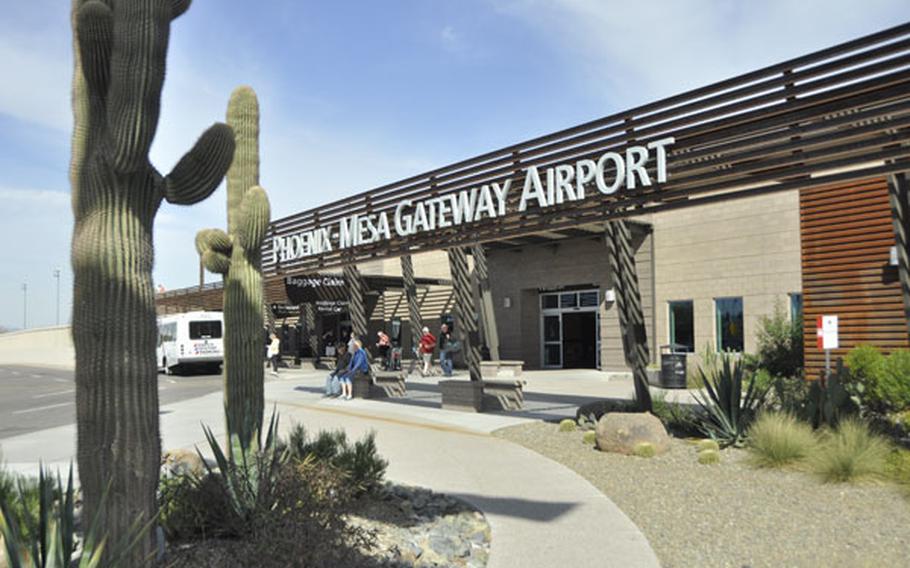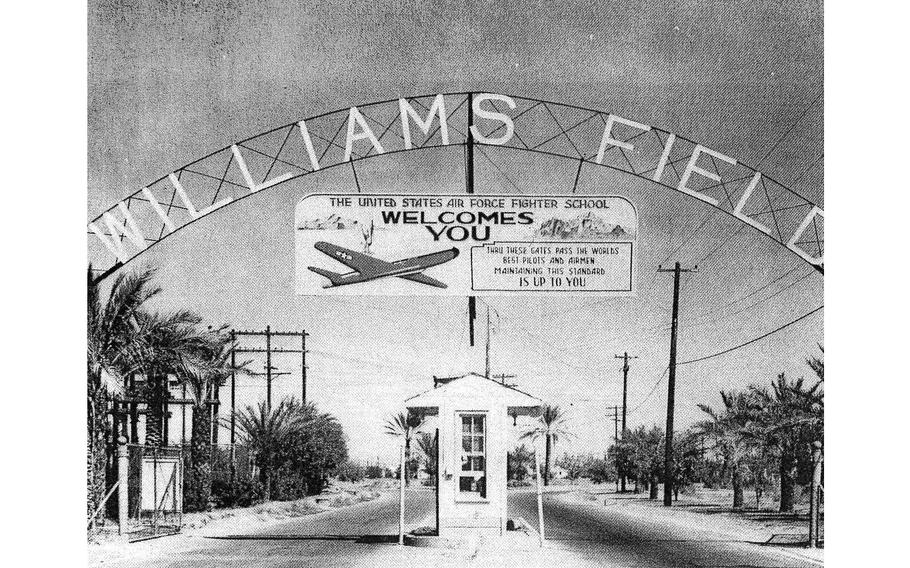
A World War II-era hangar next to the ticketing building at Phoenix-Mesa Gateway Airport is slated for demolition in the next three to four months. (U.S. Air Force)
(Tribune News Service) — A World War II-era hangar next to the ticketing building at Phoenix-Mesa Gateway Airport is slated for demolition in the next three to four months.
Hangar 24, as the war-time structure is known, is one of 10 buildings set to go down as part of a $1.4 million demolition contract approved by the airport’s board of directors recently.
The other eight buildings in the demolition contract include the 1970 traffic control tower, which was decommissioned last year after the opening of the John McCain III Air Traffic Control Tower, and four buildings erected in the 1950s.
Airport officials said the goal of demolitions is primarily to free up aeronautical land to attract new aviation-related airport users.
In the case of the World War II hangar, the airport plans to use the parcel to expand services at the passenger terminal in the future.
The airport is on the site of the former Williams Air Force Base, which the military opened in 1941 and decommissioned in 1993. Gateway Airport still has four World War II hangars standing out of nine built during the war.
The facility with its nearly 2-mile runways today serves as a reliever airport for Phoenix Sky Harbor. The facility also handles air freight and general aviation traffic.
“I hate to see them go, but I understand, especially if there’s no use for them,” Apache Junction Mayor Chip Wilson said of buildings slated for demolition.
Wilson currently chairs the Phoenix-Mesa Gateway Airport Authority’s Board of Directors. He also served at the Air Force base from 1990 to 1993.
Wilson said when the base closed, he “lost his job overnight.” Now, he’s passionate about creating jobs.
“It’s been great seeing the growth out there and the job opportunities. That’s something I’m really excited about,” he said.
Hangar 24 and another WWII hangar have been earmarked for redevelopment since early in the airport’s history. In 1996, the National Park Service performed an extensive documentation process called a Historic American Buildings Survey on Hangar 24 and two other WWII hangars.
The surveys are intended to mitigate the loss of heritage when a historic building is demolished.
Last year, the State Historic Preservation Office sent an email to airport administrators stating that the agency has no objections to the demolition of the hangar.
“SHPO is pretty careful with regard to demolition of properties,” said Mesa Preservation Foundation President Vic Linoff.
But Linoff added that Mesa’s Historic Preservation Office and Board should still be consulted prior to a demolition moving forward.
A city spokeswoman said staff is looking into the issue.
The airport’s WWII hangars have extensive documentation, but less exists for the other buildings slated for tear down.
A third-party consultant conducts an annual report on the airport’s historic properties.
Outside of ancestral American Indian sites, the latest report only identifies the WWII hangars as historic; there’s no history on the 1970 tower or the 1950s buildings mentioned in the demolition documents.
From the street, Hangar 24 appears to be in good shape, but it’s in a challenging area for preservation: close to the heart of the airport’s passenger operations, which PMGA’s leadership wants to grow.
Airport Communications Director Ryan Smith said the airport is eyeing inspection services for international flights at the site of the old hangar, plus other passenger services.
In meeting documents, the airport called the redevelopment of the hangar and other structures a “rare aeronautical opportunity” which will bring “significant economic benefit” to the airport.
The airport’s first priority is to redevelop 10 acres of land at a distance from the World War II hangar.
While the Hangar 24 and other old buildings will not be redeveloped right away, the airport administration determined it would be most cost effective to bid and demolish all the buildings at once.

Hangar 24 harkens back to the base’s earliest phase, when it was known as Williams Field and used to train pilots during World War II. (Facebook)
Hangar 24 harkens back to the base’s earliest phase, when it was known as Williams Field and used to train pilots during World War II. The first class of 300 pilot cadets arrived in 1942, about three months after the attack on Pearl Harbor.
Between 1941 and 1942, the population of the base grew from 350 to 3,000.
According to a history in the Library of Congress, local contractor Del Webb built Hangar 24 in the second half of 1942. Del Webb also built housing and other structures on the base.
After the war, Williams Air Force Base continued to train pilots. Its focus shifted to fighter pilots in 1945.
During the Second World War, servicemen learned to fly and operate P-38 Lightnings and B-17 Flying Fortresses, among other aircraft.
Those warbirds still fly Gateway Airport. Thirty minutes after the airport’s board of directors approved the 10 demolitions, attendees at a groundbreaking heard the rumble of a B-17 from Falcon Field’s Commemorative Air Force and craned their necks to see the plane coming in for a landing and takeoff from Gateway.
(c)2024 East Valley Tribune (Mesa, Ariz.)
Visit www.eastvalleytribune.com
Distributed by Tribune Content Agency, LLC.